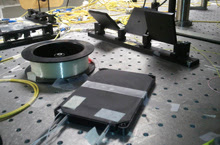By Kate Greene
The device could one day let superfast quantum computers talk to each other.
 |
| Switch it up: The components shown here can reroute entangled photons. Credit: Prem Kumar |
The Internet is made of photons that zip through fiber-optic cables and flow through devices like switches, modulators, and amplifiers. But those standard devices would be inadequate for superfast quantum computing or communications—experimental approaches that exploit the peculiar properties of particles at the quantum scale to carry out complex calculations incredibly quickly or to prevent anyone from eavesdropping on messages.
Commercial switches have various problems that make them unsuitable for rerouting entangled photons. Those that are made of micro-electromechanical components keep entangled states in tact, but operate too slowly. Other opto-electronic switches either add too much noise so that single photons are difficult to detect, or they completely destroy the quantum information.
Prem Kumar, professor of electrical engineering and computer science at Northwestern University, has developed a quantum routing switch that can shuttle entangled photons along various paths while keeping the quantum information intact.
The device could be particularly useful for quantum computing, says James Franson, professor of physics at the University of Maryland, Baltimore County. "To build a quantum computer using photons, we need the ability to switch [entangled] photons," says Franson. A quantum switch could also someday allow entangled photons from different quantum computers to be shared over long distances—like cloud computing, but with quantum information.
No comments:
Post a Comment